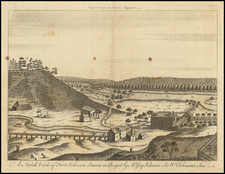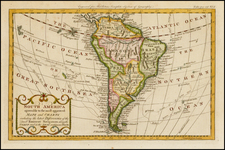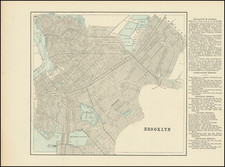Impressive 1709 Petition to Queen Anne for Reimbursement of Expenses in Queen Anne's War -- Manuscript on Vellum Signed by a Who's Who of Colonial New York
A remarkable and visually impressive colonial document, being a petition adopted by the Assembly of the Colony of New York, and presented to Queen Anne of Great Britain (1665-1714), seeking reimbursement for expenses and resources provided by them for a failed military adventure to conquer French Canada during Queen Anne's War (1702-13).
The beautiful document is signed by the colonial Lieutenant Governor of New York, Richard Ingoldsby, as well as 25 members of the New York and New Jersey Provincial Assemblies, including many prominent New York and New York City-area colonists, erstwhile mayors of New York and several members of the van Rensselaer family.
The petition seeks reimbursement for a military assault on French Canada, and details at length the preparations made by the petitioners, at their own expense. In addition to the costs of outfitting numerous vessels and canoes for the transportation of troops that never arrived, the aggrieved North Americans outline expenses of victualling "Six hundred of the four Nations and River Indians . . . And that besides the s'd Indians, their wifes and Children being upwards of One Thousand were Vitualled a Considerable time at Albany at the only Charge of this Colony."
The petition is dated November 12, 1709 and is signed by 25 prominent men of affairs, mostly members of the New York and New Jersey Assemblies, including:
- Col. Pieter Schuyler, first mayor of Albany, Commissioner of Indian Affairs, and later Governor of New York
- Richard Ingoldesby, Lieutenant Governor of New York
- Pietor Herring
- Major Johannes Hardenbergh (1670-1745), Sheriff of Ulster County; owner of the "Hardenbergh patent," some 2,000,000 acres in the Catskill Mountains located in present day Sullivan, Ulster and Delaware Counties, which he purchased in 1706 from Nanisinos, sachem of the Esopus Indians for 60 pounds.
- Robert Livingston (1654-1728), First Lord of Livingston Manor, merchant, Secretary of Indian Affairs and member of the New York Assembly
- Cornelis Sebring (or Seberingh)
- Cornelis Beaubrunt? or Bogaert?
- Joh[annes] Cuyler (1661-1740), councilman
- John Dreake
- Josiah Hundt
- John Cuyler
- Henr[ick] Beekman (1652-1716), colonial jurist, Treasurer of the Dutch West India Company, Dutch West India Company, and later Mayor of New York, Governor of Delaware (1653-1664), and Governor of Pennsylvania (1658-1663).
- Thomas Garton
- John Stillwell
- Abraham Lahman
- Hend[rick] van Rensselaer
- William Nicoll (1657-1723), speaker of the New York General Assembly
- Ebenezer Willson, 29th Mayor of New York
- Johannes Jansen, 35th Mayor of New York
- David Provost, 24th Mayor of New York
- Myndert Schuyler (1672-1755), trader and extensive New York landowner, member of the New York General Assembly
- John Van Horne
- Roger Mompesson, Chief Justice of New Jersey, and member of both the New Jersey and New York Council
- John Barberie
- Adolph Philipse, councilman
- Rip Van Dam, councilman
- Kilian Van Rensselaer, councilman
An excerpt from the petition text here follows:
Wee, your Majesties most Dutifull and Loyall Subjects the Lieut. Govern; & Councill and Generall Assembly of your Majesties Colony of New York in America doe humbly desire leave to acquaint your [?] that wee Cheerfully and punctually Complied with your Command in the Designed Expedition against Canada, wherein wee have not only Exceeded one Quota of Men but likewise in Provisions and other Expences, without any Regard to our Ability's being persuaded that the Reduction of that place, would not only lend to the honour of your Majestie in enlarging your Dominions but to the lasting Peace and Tranquility of this and the Neighbouring Colonies in the Nothern parts of America....Likewise to impress men, vessells, horses and waggons for transporting everything...And by reason there was a difficiency in the Regular Horses... four hundred eighty Seaven men were by Act of Assembly to be detached out of the Militia but such Encouragemt. given thereby, that they all went Voluntary, part whereof were sent to Albany the 27th of May, and the Remainder followed thither on the 27th: of June, from whence they advanced by Degrees to the Wood Creek which leads into the Lake, and is Distant from Albany about Eighty Miles, and here wee must humbly crave leave to lay before your Majestie That Connecticutt Exceeds this Colony at least one third in Number of Inhabitants, that Massachusetts Exceeds both, and that the Jerseys have been but at Three Thousands pounds charge in this expedition who (by the best Computation) are not inferior to us, for tho the Settlemt: of Jersey has not been of so long astanding yett having been for many years free from raising Men or Money, whilst this Colony was constrained to doo both for securing the ffrontiers against the ffrench this Governmt: was Drained not only of most of the young men but a Considerable Number of others, who fixed and settled among them; Wee humbly mention this not only to Demonstrate that neither this Inequality nor the Disregard Pennsylvania had for your Majestie's Commands, in not furnishing so much as one Man, caused any obstruction in our Punctually Complying and even Exceeding our Quota for the sd. Expedition, being zealous to obtain the happy end proposed thereby... We now crave leave to lay at your Royall ffeet wherein the Burthen of this sd. Intended Expedition lay heavily on this Colony... That at the Intire Charge of this Colony and by the people thereof upwards of One hundred Battoes and as many Burch Canoes were built, capable to have received and Transported all the Army with their Stores and Provisions, That the fforts at Stillwater and the great Carrying place with the Store houses therein, were likewise built at our Charge before any of the Neighbouring Troops came there, That the Great ffort at the Wood Creek with the Severall Blockhouses and Store houses therein, was Cheifly built at the Charge of this Governm't. That all the Stores and provisions were at the Charge of this Colony Transported not only to Albany but from thence thorrow many difficult passages by Land and water to the Great Carrying place being about Seaventy Miles, that besides the Troops raised and provided for by this Colony, they furnished at their own Charge provisions for your Maj'ties Regular fforces, and for Six hundred of the four Nations and River Indians . . . And that besides the s'd Indians, their wifes and Children being upwards of One Thousand were Vitualled a Considerable time at Albany at the only Charge of this Colony, and so were likewise all the Severall Messages for Engaging them in the Expedition all which Charges amounting to upwards of Six Thousand Pounds wee were the Readier to lay on this Governm't by reason Collo. Nicholson and Collo Vetch Assured us, that your Maj'tie would Reimburse us.
Queen Anne's War
Queen Anne's War (1702–1713) was the second in a series of French and Indian Wars fought in North America involving the colonial empires of Great Britain, France, and Spain.
The war took place during the reign of Anne, Queen of Great Britain. In Europe, it is generally viewed as the American theater of the War of the Spanish Succession; in the Americas, it is more commonly viewed as a standalone conflict. It is also known as the Third Indian War. In France it was known as the Second Intercolonial War.
The present petition for reimbursement involves an assault organized by Francis Nicholson and Samuel Vetch, who are named in the document, against New France in 1709. Spurred in part by offers of financial support from the crown, Nicholson and Vetch devised a plan for an overland expedition to attack Montreal via Lake Champlain, along with an assault by New York naval forces against Quebec. The overland expedition reached Lake Champlain, but terminated when no British naval support for the attack on Quebec materialized. The document text makes reference to this lack of British military support.
Context of Queen Anne's War and the War of the Spanish Succession
Following the death of King Charles II of Spain (1661-1700) and the subsequent outbreak of the War of the Spanish Succession in Europe, old regional and trade rivalries between the British and French came to a head. In North America these rivalries involved Native American allies. Blood was shed as violence erupted in many of the vaguely defined borders in New York and New England. Although both the French and British were reluctant to disrupt the lucrative fur trade and upset the delicate balance with the Iroquois and other native groups, by 1708 the British government began to view its defensive policy in North America as futile. In 1709 colonial leaders Francis Nicholson and Samuel Vetch devised an ambitious plan to invade and conquer New France (present-day Canada), and with the support of Queen Anne, resources and troops were requisitioned from numerous North American colonies, including New York. The planned military assault involved a two-pronged attack, comprising one overland assault on Montreal and a simultaneous assault on Quebec from the sea. With the assistance of the colonial governments troops were gathered and by the fall they stood ready and in wait of a British fleet sailing to North America to commence their assault.
By July 1709, the British government's strategy changed as they began to view the European theater of war as more important in the larger conflict. They hastily abandoned the Canadian invasion, and the British fleet was redirected to Portugal. News of the Crown's change of plans did not reach the out-posted troops until October 1709, and their subsequent retreat proved to be a catastrophe. Many troops abandoned their posts and destroyed their fortifications, leaving the Albany frontier practically without defense. When Robert Hunter (1666-1734) became colonial governor of New York in 1710, he found that due to the military preparations of the previous year, the state's treasury was practically depleted.
Returning to 1709, later in the year Vetch and Nicholson were sent to Great Britain to urge the Crown to plan a new assault to take New France, but the British government viewed the undertaking as beyond reach. A smaller and more manageable plan to invade Nova Scotia was instead approved, and by the summer of 1710 the British had successfully taken control of Port Royal (present-day Nova Scotia). This marked the end of French rule in peninsular Acadia, and the territory became a persistent point of struggle until the British success in the Seven Years' War.
The unique colonial manuscript offered here documents the consequences of Vetch and Nicholson's plan, specifically the onerous financial burden placed on the New Yorkers during this fascinating chapter in the history of colonial North America. Of particular interest is the reference in the document to supplying and victually Native Americans allies as part of the planned offensive.
A spectacular and large colonial New York document on vellum, of prime interest and importance in the history of Queen Anne's War, shedding light on the aftermath of the failed military attack on French Canada by British colonists and their Native American allies.
Provenance
Parke-Bernet Galleries, Inc., New York, Autographs and Letters Collected by the Late John Wanamaker, October 25 and 26, 1939, Lot 295
From the library of Richard Maass (1919-1998), noted collector and founding member of The Manuscript Society.











![[ British Colonies in North America ] Carte Nouvelle de L'Amerique Angloise contenant tout ce que les Anglois possedent sur le Continent de L'Amerique Septentrionale . . .](https://storage.googleapis.com/raremaps/img/small/100143.jpg)
![[ Ottawa ] City of Ottawa Canada West](https://storage.googleapis.com/raremaps/img/small/74782.jpg)

![[First State of the Popple Key Sheet] A Map of the British Empire in America with the French and Spanish Settlements adjacent thereto by Hen. Popple.](https://storage.googleapis.com/raremaps/img/small/92714.jpg)